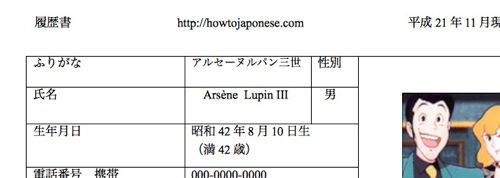Reposted from http://howtojaponese.com/2009/11/20/rirekisho-japanese-resumes/
履歴書 – Japanese Résumés
Japanese résumés, unlike American résumés (and I assume other Western résumés), follow a rigid format. They sell special résumé paper here that is gridded into different categories. Applicants fill them out by hand in their prettiest handwriting and stick on a photograph of themselves.
If you have confidence in your kanji skills and a ton of free time, you might consider filling yours out by hand – that would have to be really impressive to anyone looking to hire. I myself couldn’t be asked, so I created a résumé in Word using tables. It covers all of the basic categories and was relatively easy to edit. I’ve edited it into a mock résumé for Lupin III and uploaded it here. Feel free to download it and adapt it for your own uses. I originally created the file in Word but have been editing it in Open Office, so I apologize if the formatting is a little finicky. If it comes in handy for you, send me your success story.
A couple of interesting differences with an American résumé:
- Japanese use photos on their résumés. You will go far if you are tall, dark, and handsome with striking sideburns.
- Japanese put their date of birth, age and sex on résumés. Too many X chromosomes, and you may be serving tea.
- A lot of people list their hometown and parents. I was encouraged to do this by a teacher I was working with. This could be especially effective for foreigners because katakana may help with the pronunciation of difficult city names.
- There is a lot of what they call 自己PR (literally “self public relations”) that goes on with résumés and also job hunting in general. It reminds me of the pep rallies at the junior high school where I taught. The teams lined up individually and the kids had to give a self-introduction. They go down the line one by one and say a little sentence about themselves: “Hello, I’m Taisuke in the second year. I will do my best at the tournament and run as fast as possible.” The kids all vary their statements slightly (“I will give my best effort.” “I won’t ever give up.” etc.), and I always felt bad for the last guy because all the good words had been taken! 自己PR is kind of like this, but you have to say what your strong points are. I always felt like it was a load of crap. To give you an idea, here’s what I use on my actual résumé: ひとつのことにこだわらずに、いろいろな角度で物事を考え、見て、行動できることです。そのときの状況を踏まえて行動できるからこそうまくいきます。 Basically I have a short attention span and am good at extemporaneous bullshitting. And remember, those words are mine – you’re next in line, so get your own!
- While the document is two pages, Japanese résumés are double-sided, so this is actually a one-page résumé. Always print them on one page.
Enjoy!
Tags: Japanese job hunting, Japanese resumes, 履歴書, 自己PR
8 Responses to “履歴書 – Japanese Résumés”
-Updated by Vince on 22 Feb 2013
|






November 20th, 2009 at 9:19 pm wow, thanks for this, i was just wondering how to put together a resume while here and this is really helpful
November 21st, 2009 at 7:37 am It wasn’t long ago (2003) that people were still handwriting these things.
November 21st, 2009 at 7:47 am I think they still are. I saw some handwritten ones when I was job hunting last year.
November 22nd, 2009 at 7:56 pm Hi Daniel, this post is right on time, as my CIR-ing days are coming to a close and I am trying to get a handle on job-hunting strategies in Japan! When you were applying for jobs, did you submit a 職務経歴書 along with your resume? Is it something that you should always turn in just in case, or only when the employer asks for it?
November 22nd, 2009 at 11:35 pm Hmm…I didn’t submit a separate 職務経歴書, but I did include all of my relevant jobs and experience on the regular Japanese resume I made. I was never asked for anything in addition to what I submitted.
November 22nd, 2009 at 11:38 pm From facebook friend Geraldine: Do you know you can download very good Word and Excel templates from the microsoft Japanese URL? Once printed, they look exactly like the one you buy.
The thing that upsets me the most is the Education section. One line for the year you entered high school, one more for the year you finished high school. Seriously, who cares which high school you’ve graduated from? It’s a waste of those precious lines!
Even though the education of a Japanese applicant usually consists of four lines (two for high school, two for uni), the resume allows enough lines for a PHD. But you’ll run out of space if you have more than one degree at each level…
The same is true for the Employment section : one line per experience, and you don’t have many lines since in Japan, people who change employers too often are still considered to have some kind of a problem. You are not supposed to write how great you were in each position, which I suppose is good if you actually weren’t. You’ll just look as good as people who were (good).
Really hard to sell yourself with a Japanese resume…
And Wake: I haven’t had to write a Japanese resume, but we recently had to include a family picture on our daughter’s kindergarten application. Also, my brother-in-law applied to a wife-finding service and had to include *my* education and job history.
To which I responded:
Whoa, Wake. That’s intense on both accounts. Has he found a wife yet?
And Geraldine, do you have the links to the templates? I’d love to share those. Oh, and by the way, you clearly have too many degrees. ;o) I think the back is definitely where you BS about your specific skills/experience.
And Geraldine responded: Sure! You’ll find all many microsoft templates here (Japanese only):
http://office.microsoft.com/ja-jp/templates/CT101043371041.aspx
The classical one being http://office.microsoft.com/ja-jp/templates/TC010592951041.aspx?CategoryID=CT101448941041 (Excel) or http://office.microsoft.com/ja-jp/templates/TC010570881041.aspx?CategoryID=CT101448941041(Word)
November 25th, 2009 at 8:28 pm Facebook friend Rocco says: mmmm… I suggest writing both a 履歴書 as well as a職務経歴書 if you are applying for a job. 職務経歴書 is more forgiving with space and gives one ample opportunity to plug education and work history.
And Kaida says: When I applied for current/ past employers (all 外資系 – western companies’ subsidiaries in Japan) , I didn’t hand in Japanese style resume. I submit western style one and it’s direct translation in English.
Japanese style resume is widely used for old-stylish companies with lifetime employment because they need a person who can work for a company for a long time. What HR looks for are motivation, good education history, and potential. That’s why “self public relation” is important – not job achievement.
Japanese traditional style resume is not used widely anymore at blue chips. Panasonic only takes western style resume (they have their own style format, you can fill them in Japanese) and Sony requires you to type them online (Japanese resume could be used only for first screening)
And I replied:
Rocco: Hey cool, someone asked me about 職務経歴書 on the website comments, so I’ll post up your suggestion.
Kaida: Thanks for the great info! Very detailed and useful. I never did too much serious 就職活動, so I only had the chance to give out a couple of my resumes. I found that the Japanese formatted resume was a nice ice-breaker at job fairs and stuff, especially if you can talk to someone important. I only applied to one company and had to fill out all the information on computer anyway, but I think even just having a formal-looking resume was a plus.